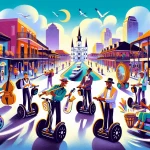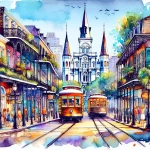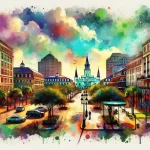Located in New Orleans, a city admired for its distinctive culture and storied past, Central City embodies the essence of the Big Easy’s multifaceted heritage. With a history spanning over two centuries, Central City has witnessed the city’s triumphs and challenges, serving as a microcosm of New Orleans’ broader cultural and historical complexities.
In This Article
TL;DR
- Central City’s historical evolution showcases its transformation from a working-class neighborhood to a hub of African American culture and activism.
- The neighborhood boasts a wealth of cultural landmarks that celebrate its unique heritage, such as the Ashé Cultural Arts Center and the Oretha Castle Haley Boulevard.
- Central City has been at the forefront of influential social and community movements, like the Southern Christian Leadership Conference and the Congress of Racial Equality, shaping New Orleans‘ history.
1. Historical Overview of Central City
Central City’s story begins in the early 1800s when the area near Saint Charles Avenue first witnessed development. The opening of the New Orleans & Carrollton Railway and the New Basin Canal attracted commerce and a diverse population of Irish, Italian, German immigrants, and working-class residents.
As the 19th century progressed, Central City continued to grow and evolve. Dryades Street emerged as a thriving commercial district in the 1830s, and the construction of the Dryades Market in 1849 solidified the area’s status as a communal hub. After the American Civil War, an influx of African Americans from rural towns settled in the neighborhood, and by the 1870s, the urban area had expanded to Claiborne Avenue.
The early 1900s saw Central City become the largest New Orleans neighborhood patronized by African American residents during the Jim Crow era and the main center for the Uptown African American community. The district’s post-World War II heyday boasted over 200 businesses, reflecting its thriving economic landscape.
However, the late 1960s marked the beginning of a decline for Central City. The following decades saw a gradual economic downturn, culminating in a peak of depreciation by 1990, characterized by numerous vacant lots and buildings. It wasn’t until the early 2000s that community-driven revitalization efforts began to breathe new life into the neighborhood, a process further accelerated by the aftermath of Hurricane Katrina.
2. Cultural Tapestry of Central City
Central City’s cultural heritage is a rich amalgamation of diverse influences, ranging from African and Caribbean to French and Spanish. This unique blend of cultures has shaped the neighborhood’s identity, manifesting in its vibrant music and arts scene.
The area’s musical legacy is particularly noteworthy, with jazz pioneers like Buddy Bolden and Kid Ory once calling Central City home. Today, venues such as the Ashé Cultural Arts Center and the New Orleans Jazz Market showcase local talent and celebrate the neighborhood’s musical roots.
3. Architectural and Landmark Highlights
As a National Register Historic District, Central City boasts a captivating array of architectural styles and significant landmarks that define its streetscape. Notable buildings, such as the Myrtle Banks Building on Oretha Castle Haley Boulevard, stand as testaments to the neighborhood’s storied past.
Preservation efforts have been ongoing to protect Central City’s architectural heritage, with organizations like the Central City Renaissance Alliance working to restore and repurpose historic structures. However, the challenges of modern development and the need for revitalization have sometimes put these preservation goals at odds with the demands of progress.
4. Social and Community Movements
Central City has been at the forefront of significant social and community movements that have shaped the course of New Orleans’ history. The neighborhood played a pivotal role in the Civil Rights Movement, with the Southern Christian Leadership Conference being founded here in 1957 during a meeting with Martin Luther King Jr.
The Congress of Racial Equality (CORE) also has its roots in Central City, further cementing the neighborhood’s status as a bastion of activism. In the 1960s, the Dryades Street boycott, led by local civil rights activist Oretha Castle Haley, protested against segregation and discriminatory practices.
Today, community organizations like the Central City Renaissance Alliance and the Oretha Castle Haley Boulevard Merchants and Business Association continue to carry the torch of activism, working towards the betterment of the neighborhood and its residents.
5. Economic Landscape
Central City’s economic landscape has undergone significant changes over the years. Once a thriving commercial hub with over 200 businesses during its post-World War II heyday, the neighborhood experienced a gradual decline in the late 1960s and beyond.
However, recent revitalization efforts have aimed to breathe new life into Central City’s economy. The Oretha Castle Haley Boulevard, in particular, has been the focus of economic development initiatives, with new businesses and cultural institutions setting up shop along this historic thoroughfare.
6. Cultural Institutions and Education
Education and cultural institutions play a vital role in preserving and promoting Central City’s rich heritage. Schools like the Mahalia Jackson Elementary School and the James M. Singleton Charter School serve the neighborhood’s youth, while cultural centers such as the Ashé Cultural Arts Center and the McKenna Museum of African American Art celebrate its artistic legacy.
The Southern Food and Beverage Museum, located on Oretha Castle Haley Boulevard, is another notable institution that showcases the culinary traditions of the American South, with a focus on New Orleans’ unique gastronomic heritage.
7. Community Profiles
Central City’s story is ultimately one of its people—the individuals and families who have shaped its character and embodied its resilient spirit. Civil rights activists like Oretha Castle Haley and the Rev. A.L. Davis have left an indelible mark on the neighborhood’s history, fighting for equality and justice during the tumultuous years of the Civil Rights Movement.
Today, community leaders and organizations continue to carry on this legacy, working tirelessly to improve the lives of Central City’s residents. The Oretha Castle Haley Boulevard Merchants and Business Association, for example, has been instrumental in revitalizing the neighborhood’s main commercial corridor, attracting new businesses and cultural institutions.
8. Future Outlook
As Central City looks to the future, there is a palpable sense of hope and determination among its residents and stakeholders. Planned developments, such as the revitalization of the Myrtle Banks Building and the expansion of the Ashé Cultural Arts Center, promise to bring new opportunities and growth to the neighborhood.
Community-driven initiatives, like the Central City Renaissance Alliance’s efforts to restore historic buildings and promote affordable housing, are also key to ensuring that the benefits of revitalization are felt by all residents.
Ultimately, the future of Central City lies in the hands of its people—those who have called this neighborhood home for generations and those who have been drawn to its unique character and potential. As the community continues to come together to celebrate its heritage, confront its challenges, and shape its destiny, one thing is certain: Central City’s story is far from over, and its best chapters may yet be unwritten.






